Royal Domain of Drottningholm: Drottningholm Palace stands on Lovön Island in Lake Mälaren, situated on the western outskirts of Stockholm. Drottningholm is the home of the Royal Family of Sweden. Drottningholm Palace was destroyed by fire in 1661. A new palace was designed and the works started in 1662. Drottningholm Palace was rebuilt as we know it today. Drottningholm Palace was inspired by Versailles. Drottningholms Slottsteater was built in 1766 in the park of Drottningholm Palace. There are only five theaters of this kind in the world: one in Russia, one in Litomyšl Castle and one in Český Krumlov and two in Sweden. The Chinese Pavilion Kina Slott in Drottningholm Palace Park is an important example of the 18th century Chinoiserie, a style inspired by the art and design from China and other Asian countries. The Kina Slott was built in 1769. Most of the sculptures in Drottningholm Park are created by the Dutch artist Adriaen de Vries, one of the most famous sculptor of his generation. Adriaen de Vries, known as the Dutch Michelangelo, worked for several aristocratic families in Europe and was the court sculptor of Emperor Rudolph II in Prague. Drottningholm Palace is a great example of a royal residence built in the 17th and 18th centuries. Two other UNESCO World Heritage Sites close to Stockholm are: Skogskyrkogården and Birka and Hovgården The Royal Domain of Drottningholm gained the status the as a UNESCO World Heritage in 1991.
www.werelderfgoedfotos.nl © Copyright World Heritage Photos

Royal Domain of Drottningholm: Drottningholm Palace is the private home of the Royal Family of Sweden. The 17th century Drottningholm Palace stands on the Lovön Island in Lake Mälaren, just west of Stockholm, Sweden. The present palace was built for Queen Hedvig Eleonora after an earlier palace was destroyed by a fire in 1661. The name Drottningholm means the 'Queen's Island'. The Royal Domain of Drottningholm was declared a UNESCO World Heritage in 1991.
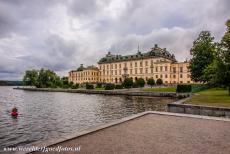
Royal Domain of Drottningholm: Drottningholm Palace is the private home of the Royal Family of Sweden. The 17th century Drottningholm Palace stands on the Lovön Island in Lake Mälaren, just west of Stockholm, Sweden. The present palace was built for Queen Hedvig Eleonora after an earlier palace was destroyed by a fire in 1661. The name Drottningholm means the 'Queen's Island'. The Royal Domain of Drottningholm was declared a UNESCO World Heritage in 1991.
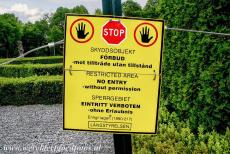
Royal Domain Drottningholm: Forbidden areas of the gardens. The palace park includes two different garden styles, an English garden and a formal French garden, or Baroque garden. The oldest parts of the gardens were created at the end of the 17th century. The greater part of the palace and areas of the gardens are open to visitors almost all year round. The Drottningholm Palace is both a UNESCO World Heritage and the main residence of the Swedish Royal Family.

Royal Domain of Drottningholm: The Royal Chapel of Drottningholm was inaugurated in 1746, it has been in continuous use ever since. Through the ages, the Royal Chapel of Drottningholm has witnessed many royal christenings and other royal events, the chapel also serves as a parish church. A high mass is held on the last Sunday of every month. The door on the south side of the chapel leads directly into the palace.
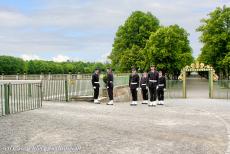
Royal Domain of Drottningholm: The Royal Guards at Drottningholm prepare for the changing of the guards. The Royal Guard was established in 1523 and initially consisted of 100 to 200 soldiers. They were also responsible for the safety of the city of Stockholm and also served as fire guards. The changing of the Royal Guards is a hundred years old ceremony, it takes place every day at twelve o'clock. It is now a popular tourist attraction.

Royal Domain of Drottningholm: The Royal Guard at Drottningholm Palace. The 16th century Drottningholm was destroyed by fire in 1661, a new palace was designed, the works started in 1662. Drottningholm Palace was rebuilt as we know it today, it is a well preserved royal palace. Drottningholm was inspired by the Palace of Versailles in France. The Drottningholm Palace is the primary residence of the Royal family of Sweden. The royal apartments are situated in the south wing of the palace.
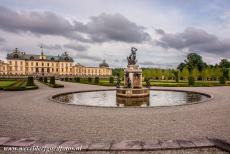
Royal Domain of Drottningholm: The Hercules Fountain was created by the Dutch sculptor Adriaen de Vries. The Hercules Fountain stands at the centre of the Drottningholm Palace Park. Museum De Vries at Drottningholm Palace houses an unique collection of sculptures by Adriaen de Vries, his sculptures were loved and admired by many royal houses in Europe. In 1648, after the Thirty Years War, the bronze sculptures were were brought to Sweden as booty and placed in the park of Drottningholm.
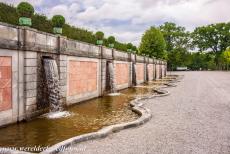
Royal Domain Drottningholm: Water Cascades in the Baroque gardens of Drottningholm. In the past, the water was brought to the cascades and fountains via an imposing network of ditches, ponds and an underground piping system, made of hollowed-out tree trunks. The water came from several ponds north of the park. The Baroque gardens of Drottningholm were restored during the 1950s and 1960s. The Water Cascades and Crown Fountain were reconstructed and are now fed by a moderm pumping equipment.

Royal Domain Drottningholm: The renowned Hercules Fountain, Drottningholm Palace in the background. The Hercules Fountain was created by the Dutch sculptor Adriaen de Vries, known as the 'Dutch Michelangelo', his works are equally rare. Adriaen de Vries worked for aristocratic families in Europe and he was the court sculptor of Emperor Rudolph II in Prague. The bronze sculptures in Drottningholm Park were created by Adriaen de Vries.
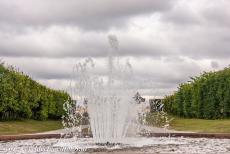
Royal Domain Drottningholm: Drottningholm is located behind the Crown Fountain. The Crown Fountain stands at the centre axis of the gardens. Large parts of the French Baroque gardens have been preserved. The original bronze sculptures by the Dutch artist Adriaen de Vries (1556-1626), a celebrated sculptor at the time, have now been replaced by replicas. The originals are housed in Museum De Vries at Drottningholm. The museum houses the largest collection of the work of Adriaen de Vries in the world.

Royal Domain of Drottningholm: The Chinese Pavilion, Kina Slott, in the Drottningholm Palace Park, was a birthday present for Queen Lovisa Ulrika in 1753. At that time, Chinese objects and textiles were the highly fashionable among the nobility of Europe. The original wooden Chinese Pavilion was replaced by a more permanent Chinese Pavilion, this second and current Kina Slott was completed in 1769. The Kina Slott is decorated in the Chinese Swedish Rococo style.

Royal Domain of Drottningholm: The Kina Slott is a small Chinese Pavilion in the palace park. The Kina Slott is an important example of the Chinoiserie in the 18th century. The Chinoiserie style is a mixture of Western and Oriental art and architecture. In the 18th century, Chinoiserie was a highly popular style among the royals and aristocrats of Europe. Many Chinese objects were imported by the Swedish East India Company.

Royal Domain of Drottningholm: The Corps de Garde Building, also known as the Guards' Tent. The Corps de Garde Building was designed in the style of a Turkish tent. The tent was built in 1781-1782 for the Royal Guards of the Kina Slott, the Chinese Pavilion. The tent was restored in the 1990s and it regained its original colours. At the facade, the timber structure of the tent is covered by painted panels, just like a stage set, while the rear has traditonal wooden panels.

Royal Domain of Drottningholm: The Drottningholms Slottsteater is an opera house located in the garden of Drottningholm Palace. The present Drottningholm theatre was built in 1766 for Queen Lovisa Ulrika. An earlier theatre was destroyed by a fire in 1762. The theatre is still in use and can accomodate about 400 spectators. The theatre uses still its original stage machinery, it includes wind, cloud and thunder machines. The stage machinery it is operated by hand.

Royal Domain of Drottningholm: Drottningholm Palace is surrounded by a French Baroque garden and an English garden. The palace gardens are open all year round and free to enter. Drottningholm Palace, including the Drottningholm Theatre, the Kina Slott and the gardens, is a good example of a royal residence built in the 17th and 18th centuries. Drottningholm Palace was inscribed on the UNESCO World Heritage List in 1991.
